Looking for a perfect Aurangabad itinerary for 2 days? Then you are at right place. Here I am going to explain how to plan a visit to Aurangabad for 2 days, history of some important places, best places to visit in Aurangabad, best time to visit Aurangabad and many more helpful things for you. So let’s begin your journey of “Tourism Capital Of Maharashtra”.
Table of Contents
Do you know??
Aurangabad, located in the state of Maharashtra, it is also called the “Tourism Capital of Maharashtra.” Aurangabad is known for its historical significance, as it is home to UNESCO World Heritage Sites like the Ajanta and Ellora caves, Bibi Ka Maqbara, and ancient Devgiri fort fort. Devgiri was once the capital of famous “Yadav Dynasty”.
When I visited Aurangabad, I felt like I was walking through centuries of history, exploring remnants of different eras. During this Aurangabad itinerary for 2 days, you can experience the essence of city while understanding the historical importance of this city.
What do you know about the history of Aurangabad?

The Tomb Of Malik Amber
The city was originally founded in 1610 by Malik Ambar, a prime minister of the Nizam Shah Dynasty. The old name of Aurangabad was “Kharki.” It gained prominence when the Mughal Emperor Aurangzeb renamed the city “Aurangabad” after himself, and many of the city’s historical landmarks were established during this period.

Bibi Ka Maqbara
The most striking structure in Aurangabad is the Bibi Ka Maqbara, also called the “Taj of the Deccan.” Built by Aurangzeb’s son, Azam Shah, in memory of his mother, Dilras Banu Begum, the structure bears a striking resemblance to the Taj Mahal in Agra.
Aurangabad’s history is also linked with Buddhism, as the nearby Ellora and Ajanta Caves showcase stunning ancient Buddhist, Hindu, and Jain rock-cut temples and monasteries. These caves, dating back to the 2nd century BCE, represent an essential part of the city’s spiritual and artistic heritage.

A Beautiful View Of Ajanta Caves.
The Ellora Caves, on the other hand, feature a mix of Buddhist, Hindu, and Jain temples, showcasing the religious harmony that once existed in the region. The highlight here was the Kailasa Temple, this architectural marvel left me speechless. Carved out of a single rock, the temple is a testament to ancient India’s engineering and artistic skills.
In the 18th century, Aurangabad became part of the Hyderabad Nizam’s domain, and it remained under their rule until Indian independence in 1947.
As I explored the historical sites, I realized that Aurangabad is not just a city, but a living museum that preserves the footprints of dynasties and cultures that shaped India’s history. Walking through the city I felt like stepping into a different era, offering me an enriching experience of India’s glorious past.
How To Reach Aurangabad?
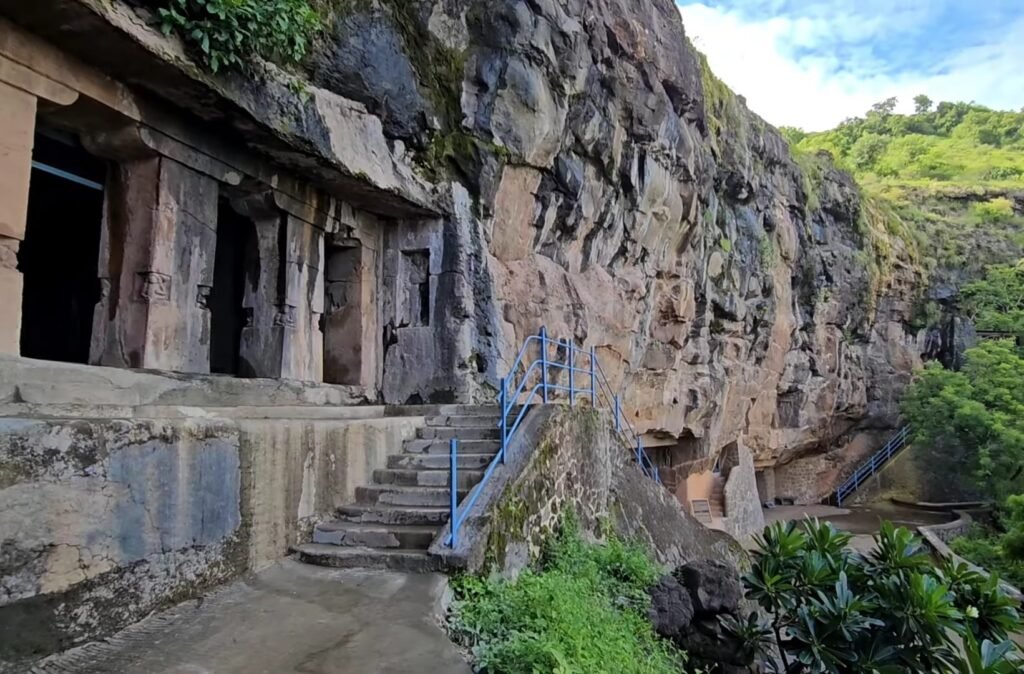
Reaching Aurangabad is quite convenient, with multiple options available, depending on your preference.
By Air:
The quickest way to reach Aurangabad is by air. Aurangabad Airport, also known as Chhatrapati Sambhaji Maharaj Airport, is well-connected to major Indian cities like Mumbai, Delhi, and Hyderabad.
The airport is around 10 km from the city centre, and you can easily grab a cab or auto-rickshaw to reach your hotel. The airport is not too large, so getting out is comparatively easy, and you can start exploring the city right away.
By Train:
If you prefer travelling by train, Aurangabad has a well-connected railway station. I’ve also travelled by train from Pune, and the journey was smooth, taking around 3-4 hours. Trains like the Dynaneswari Express and Tapovan Express are good options.
The railway station is centrally located, so once you arrive, you’re close to many hotels and tourist spots. I found train travel to be scenic, especially when passing through rural Maharashtra.
By Road:
For those who enjoy road trips, Aurangabad is accessible by well-maintained highways. I once drove from Mumbai, and the Mumbai-Aurangabad route (around 335 km) is quite scenic, taking about 4-5 hours. The newly inaugurated expressway called Samruddhi Mahamarg is very smooth, it’s a six-lane expressway that connects Mumbai to Nagpur via Sambhaji Nagar. You can also take Buses from cities like Mumbai, Pune, and Nashik.
Best time to visit Aurangabad
When planning a visit to Aurangabad, timing is important factor to consider. I visited Aurangabad during the winter, and I can say that it’s definitely the best time to visit. Let me explain why.
Winter (October to February):
Aurangabad experiences pleasant winter weather, with temperatures ranging between 10°C to 25°C, making it perfect for sightseeing. I found this season ideal for exploring the city’s historical monuments, like the Ajanta and Ellora Caves, Bibi Ka Maqbara, and Daulatabad Fort, without getting exhausted by the heat. The cool breeze and clear skies made my visit even more enjoyable.
Monsoon (June to September):
During the monsoon, Aurangabad gets moderate rainfall, and the surroundings turn lush green, especially around the Ajanta and Ellora Caves. Roads can get slippery, and exploring the caves or forts might not be as convenient. However, if you enjoy the rains and don’t mind some wet weather, monsoon can offer a quieter experience, with fewer tourists around.
Avoid Summers (March to May):
I would not recommend visiting Aurangabad in the summer, as temperatures can goes up to 40°C or more. I made the mistake of visiting in May once, and the heat was unbearable. Walking around the historical sites, especially those like Daulatabad Fort, which require some climbing, becomes extremely uncomfortable for me. The hot sun drains your energy, making it difficult to fully enjoy the beauty of the place.
If you have no other option but to visit in summer, try to start your day early, and carry plenty of water to stay hydrated.
Where to stay in Aurangabad?
When I visited Aurangabad, finding a good place to stay an important factor to make my trip comfortable and enjoyable. The city offers a variety of accommodations for every kind of traveler, from budget-friendly stays to luxurious hotels. Following are some of the best options for where to stay in Aurangabad.
Budget Accommodations (₹500 – ₹1,500 per night)
If you are a traveler like me who enjoys exploring but wants to save on accommodation, Zostel Aurangabad is a great choice. Zostel is known for its backpacker-friendly setup and lively social environment. I stayed in a dormitory here, which cost me around ₹600 per night. It’s clean, has a great common area, and is ideal for meeting fellow travelers. If you prefer privacy, they also offer private rooms for around ₹1,200 per night. Located centrally, it’s easy to get around the city from here.
Another great budget option is Hotel Manor, a simple yet comfortable hotel located in the heart of Aurangabad. Rooms here start at around ₹1,500 per night. The hotel offers basic but clean rooms with free Wi-Fi and decent service.
Mid-Range Hotels (₹2,000 – ₹4,000 per night)
For those looking for something a little more comfortable without spending too much, City offers several great mid-range options. Hotel Kailas, located near the Ellora Caves, is one of the best choices. I stayed here for ₹2,500 per night The hotel has a lovely garden area and offers both standard rooms and cottages.
The best part is that it’s within walking distance of the Ellora Caves, making it perfect for early morning visits.
The One Hotel is another fantastic option in the mid-range category. Located in a prime area of Aurangabad, this hotel offers modern amenities, clean and well-furnished rooms, and friendly staff. The rooms here cost around ₹3,000 per night. You can particularly enjoyed the complimentary breakfast they served, which featured both local and continental dishes.
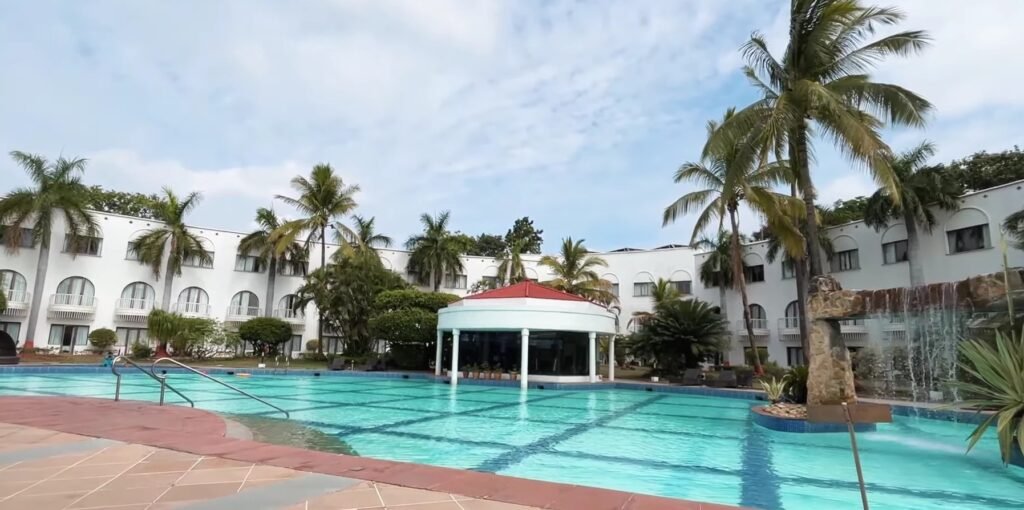
A View Of Lemon Tree Hotel.
Lemon Tree Hotel, another mid-range option, provides excellent service and comfort. The charges are around ₹3,500 per night for a standard room. It’s a bit more expensive with modern decor, a gym, and a restaurant serving a variety of cuisines. It’s an ideal spot for families or business travelers who want a balance of comfort and value.
Luxury Stays (₹5,000 – ₹10,000+ per night)
If you are looking for a luxurious stay, Aurangabad has several high-end hotels that cater to your every need. One of the best luxury experiences I had was at the Vivanta Aurangabad by Taj. This 5-star hotel is perfect for those looking to indulge. The rooms are elegantly designed, and the staff ensures that you have everything you need. Prices start at around ₹6,000 per night.
The hotel has beautiful gardens, a pool, and even a spa where I relaxed after a long day of sightseeing.
Another excellent luxury option is the WelcomHotel Rama International by ITC Hotels. This iconic property has sprawling lawns, a beautiful pool, and offers top-notch service. Rooms here start at around ₹5,500 per night. The hotel’s in-house restaurant serves a wide variety of dishes, from traditional Indian meals to international favorites.
Aurangabad Itinerary for 2 days/Best places to visit in Aurangabad.
Day 1: Visiting the Mughal Heritage and Cultural Sites.
Bibi Ka Maqbara.
Location: Google Maps
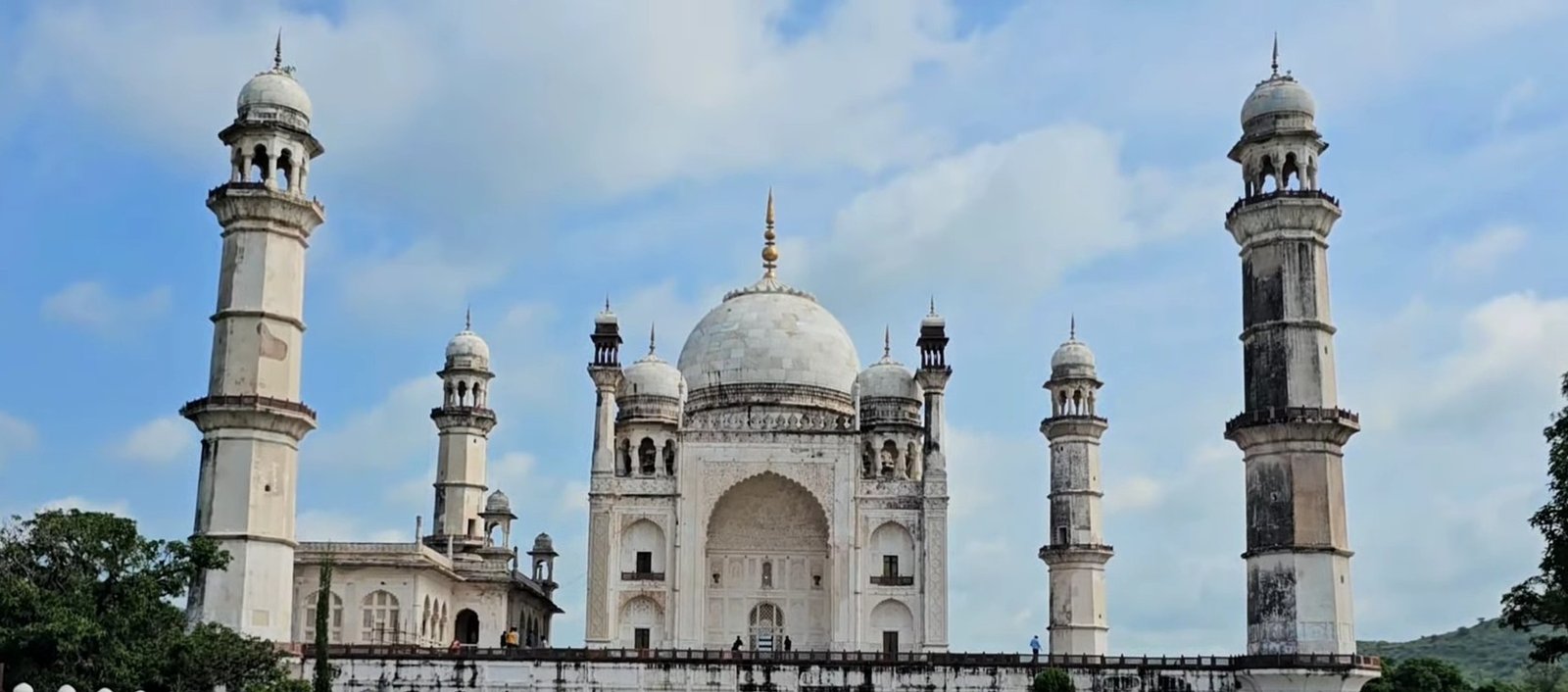
A Beautiful View Of Bibi Ka Maqbara.
My journey in Aurangabad began at Bibi Ka Maqbara, a monument often referred to as the “Taj of the Deccan.” It was built in 1660 by Prince Azam Shah in memory of his mother, Dilras Banu Begum, the first wife of Mughal Emperor Aurangzeb. The structure is often compared to the Taj Mahal because of its similar architectural style, though it is much smaller in scale. The Bibi Ka Maqbara was designed by Ata-Ullah, the son of Ustad Ahmad Lahauri, the principal designer of the Taj Mahal, which explains the striking resemblance between the two monuments.
As I entered the site early in the morning, the peaceful atmosphere was incredible. the lush gardens surrounding it made for a serene setting. The symmetry of Mughal architecture was fascinating to observe, and I spent some relaxed time walking around the Maqbara, admiring the detailed carvings and intricate inlay work.
Timings: 8 AM to 6 PM
Entry Fees: ₹50 for Indian citizens, ₹300 for foreign tourists.
Aurangabad Caves
Location: Google Maps

After enjoying the beauty of Bibi Ka Maqbara, I made my way to the Aurangabad Caves, located a few kilometres away. These caves are a set of 12 Buddhist shrines carved into a hill, dating back to the 6th and 7th centuries. They are less known compared to Ajanta and Ellora but offer a peaceful and less crowded experience. The caves are divided into two groups, and each cave contains remarkable sculptures that represent the influence of Buddhist art on it.
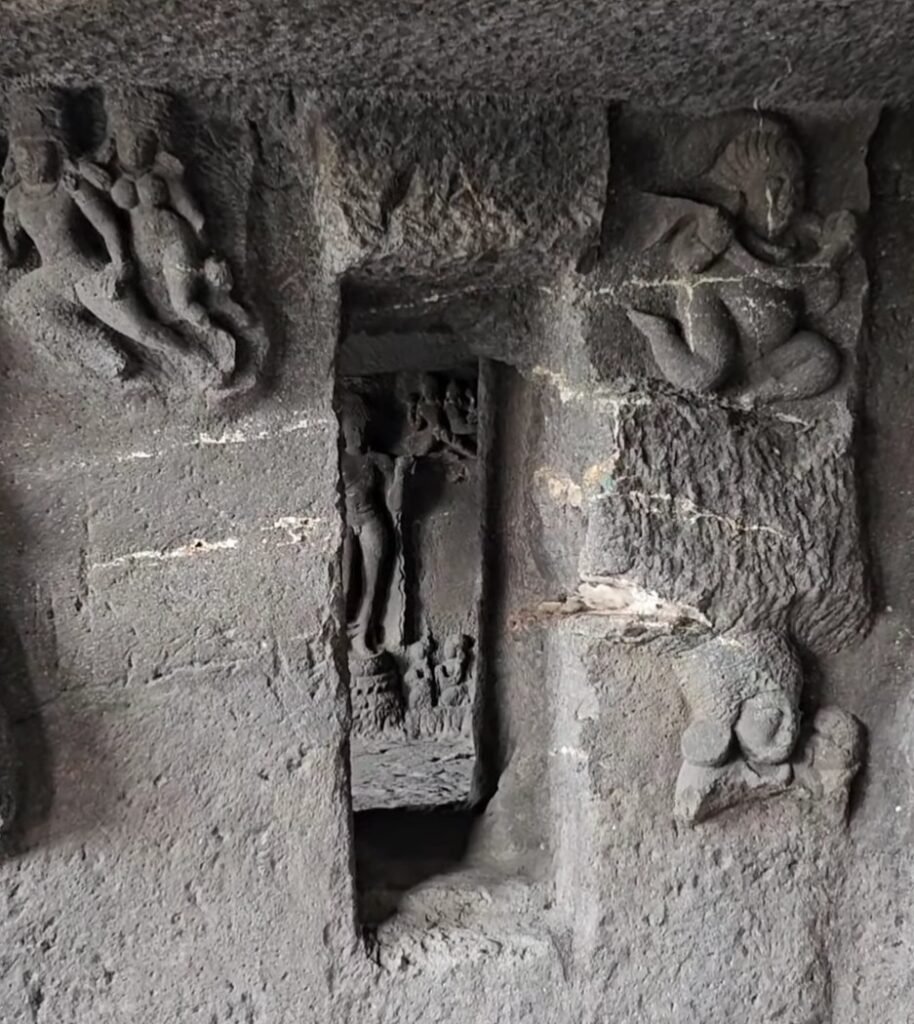
Climbing the hill to reach the caves was an adventure experience for me, as it offers a panoramic view of the city. The caves, though smaller than the more famous Ajanta and Ellora, were serene and spiritual. The intricate carvings, especially of Bodhisattvas and other figures, were amazing. I felt a deep connection to the past as I walked through the caves.
Timings: 9 AM to 5 PM
Entry Fees: ₹20 for Indian citizens, ₹100 for foreign tourists.
Panchakki (Water Mill)
Location: Google Maps

A View Of Panchakki.
My next stop was Panchakki, a 17th-century water mill located in the heart of Aurangabad. The water mill is an engineering marvel from the medieval period, using an underground water channel to grind grain. The water for the mill is brought down through a system of pipes from a spring located several kilometres away. Panchakki was not only a utilitarian structure but also part of a complex that included a mosque and the tomb of a Sufi saint, Baba Shah Musafir.
Walking around Panchakki was like taking a step back in time. The sound of flowing water was very charming to me. The attached garden was filled with local families enjoying the day, and the mosque nearby added a spiritual vibe to the entire complex. I was particularly fascinated by the effective engineering of the water mill, which continues to work today.
Timings: 6 AM to 9:30 PM
Entry Fees: ₹20 for Indian citizens, ₹100 for foreign tourists.
Siddharth Garden and Zoo
Location: Google Maps

While mostly a modern attraction, Siddharth Garden and Zoo is a popular spot for locals and tourists. The garden, named after Gautama Buddha, features lush green lawns, flowers, and plenty of places to relax. The zoo, located within the garden, is home to a variety of animals, including lions, white tigers, and elephants. While not historically significant, it provides a refreshing break after visiting Aurangabad’s historical monuments.

I headed to Siddharth Garden in the late afternoon. The well-maintained lawns and the sight of children playing made it a lively spot. The zoo added a fun element to the visit, and I enjoyed observing the animals.
Timings: 9 AM to 7 PM
Entry Fees: ₹20 for the garden, ₹50 for the zoo.
Evening:
Local Market Exploration
After a day of sightseeing, I decided to explore Aurangabad’s busy markets in the evening. I heard that The city is famous for its traditional Paithani sarees, Himroo shawls, and Bidriware (metal handicrafts). Shopping in Aurangabad was a pleasant experience. I ended up purchasing a Himroo shawl, which is crafted from a blend of silk and cotton and is unique to the region.
Day 2: World Heritage Sites and Many More
1. Ellora Caves
Location: Google Maps
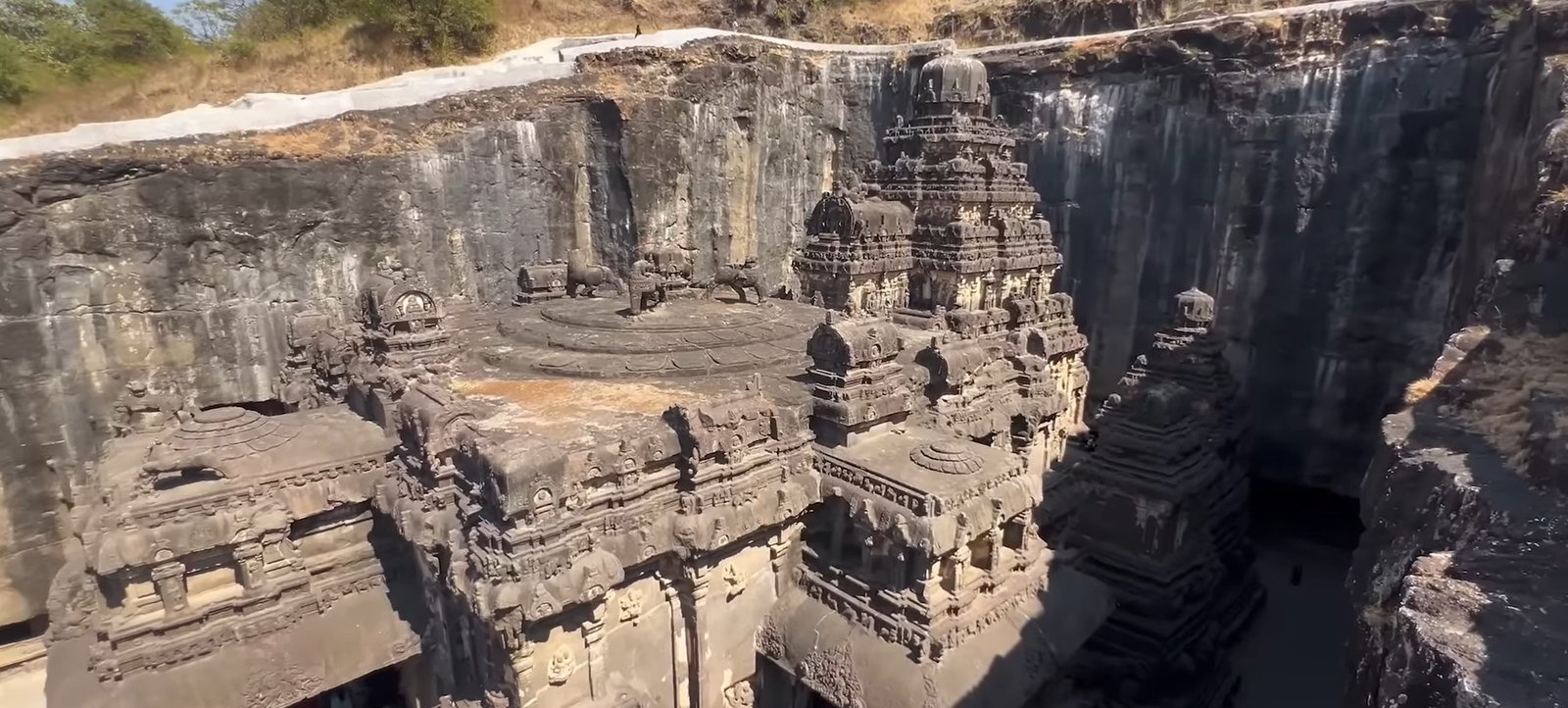
A Stunning View Of Kailasa Temple.
On the second day, my first spot to visit was The Ellora Caves, situated about 29 km from the city centre, one of the most famous tourist attractions near Aurangabad. Ellora is a UNESCO World Heritage Site and consists of 34 rock-cut temples and monasteries, which were excavated between the 6th and 10th centuries.
The caves represent three different religions: Hinduism, Buddhism, and Jainism. The most iconic cave here is the Kailasa Temple (Cave 16), which is the largest monolithic rock-cut temple in the world. It was carved out of a single block of basalt rock and dedicated to Lord Shiva.
Interesting fact:
I heard from some local tourist that the carving of this Temple continuous for several hundreds of years. Near about 20000 people have been continuously busy in carving for several hundreds of years. It is said that the temple was built by the Rashtrakuta Dynasty of Deccan.

You Can Check 20 Rupees Indian Note To See This Pillar Of Ellora.
Special tip for you: if you want to know deeply about Kailash Temple then I would suggest you take a guided tour of this Temple. I would like to suggest you spend at least 2 hours at Kailasa Temple because it is a worthy place for 2 to 3 hours.

A View Of Chaitya Vihara, Ellora.
Visiting Ellora was a highlight of my trip. The Kailasa Temple left me completely amazed—the sheer size and the detailing in the carvings were unbelievable. Standing there, it was hard to imagine how ancient artisans, with limited tools, created such a massive structure. I spent hours wandering through the various caves, each one unique in its artwork and architecture.

Top Side View Of Kailasa Temple.
Do you know?: I heard from some local people that this temple is carved upside down means the carvings started from the top of the temple and then they reached at the bottom or pillars of the temple. During the carving of the temple, there were thousands of tons of Rock taken away from the main Rock block and you cannot find this extra rock at any places nearby.
Timings: 6 AM to 6 PM (Closed on Tuesdays)
Entry Fees: ₹60 for Indian citizens, ₹600 for foreign tourists.
2. Grishneshwar Temple
Location: Google Maps

Grishneshwar Temple, Aurangabad.
The Grishneshwar Temple is one of the 12 Jyotirlingas dedicated to Lord Shiva. The present temple structure was rebuilt in the 18th century by Queen Ahilyabai Holkar of Indore. The temple’s unique architectural style blends traditional South Indian and North Indian elements, and it is an important pilgrimage site for devotees of Lord Shiva.
Visiting the Grishneshwar Temple after Ellora felt like a natural step in understanding the region’s spiritual and historical depth. The temple had a simple and peaceful ambience, and I was moved by the devotion of the worshippers. The stone-carved pillars added to the sacredness of the temple. Though modest in size compared to other grand temples, Grishneshwar Temple had an unmatched spiritual aura.

Special tip for you: there is a compulsory dress code required to enter the temple so I would like to suggest you maintain a proper address code as per the requirement of Temple authority.
Timings: 5:30 AM to 9:30 PM
Entry Fees: Free
3.Daulatabad Fort (Devgiri Fort)
Location: Google Maps

A View Of Devgiri Fort.
The next stop on my Aurangabad itinerary for 2 days was the majestic Daulatabad Fort, also known as Devgiri Fort. Built in the 12th century by the Yadava dynasty, the fort was later captured by several other dynasties, including the Mughals. The fort was strategically designed, with a series of defensive structures that included a moat, drawbridge, and massive stone walls. The fort also has a series of underground tunnels and hidden passages, which were used during battles.
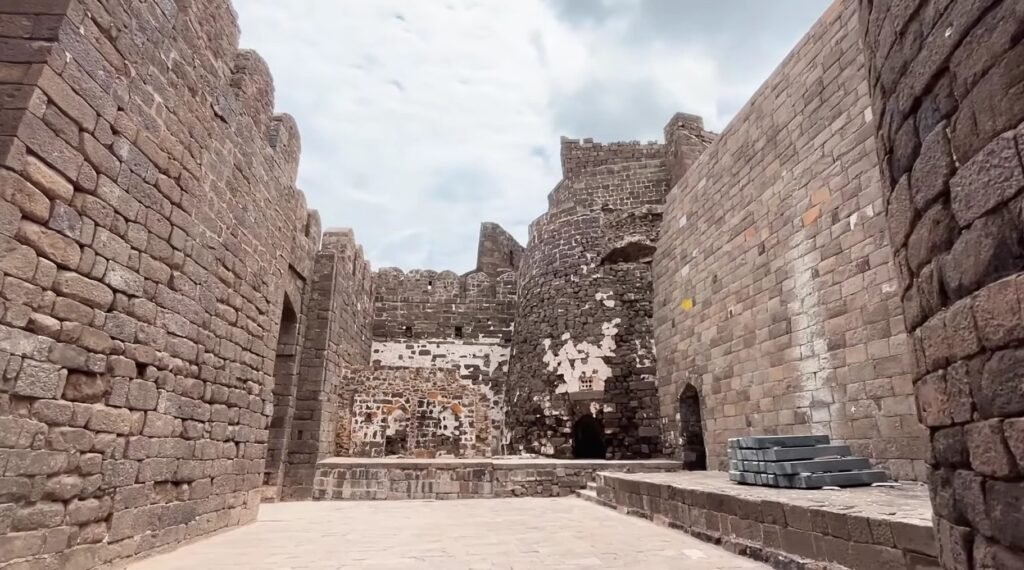
An Inside View Of Devgiri Fort.
Do you know?: this Daulatabad Fort was famous for its defence system in history so it is often called by historians as an “Undefetable Fort”. Mohammed bin Tughlaq ruler of the Tughlaq dynasty once shifted his capital from Delhi to Devgiri in 1326 after understanding the strategic importance of Devgiri.
Climbing the steep slopes of Daulatabad Fort was challenging for me. The fort’s strategic location offered breathtaking views of the surrounding landscape. As I reached the top of the fort, the panoramic view of Aurangabad made the climb worthy for me. The fort stands as a testament to the military brilliance of its creators.
Special tip for you: This Fort is spread across a very large area and it requires plenty of time to reach at the top of the Fort so I would like to suggest you that start your visit to the fort early in the morning so that you can get enough time to explore the Fort completely
Timings: 9 AM to 6 PM
Entry Fees: ₹20 for Indian citizens, ₹100 for foreign tourists.
4. Ajanta Caves
Location: Google Maps

Although Ajanta Caves is located about 100 kilometres from Aurangabad, it is worth visiting if you have time. These 29 rock-cut caves are masterpieces of Buddhist art, from between the 2nd century BCE and the 6th century CE. The Ajanta Caves are famous for their impressive paintings and sculptures, which have some incidence from the life of the Buddha and stories from the “Jataka”. The caves are also a UNESCO World Heritage Site and represent one of the finest examples of ancient Indian art and architecture.

A Statue Of Buddha At Ajanta.
While Ajanta Caves are slightly farther away, the visit was entirely worth the trip. As I entered the caves, I was greeted by murals and sculptures, which showed scenes from Buddha’s life. Despite being centuries old colours of these paintings look fresh.

Beautiful Display Of Artwork From Ajanta Caves.
I spent hours inside the caves, and carefully observed the attention to detail, especially in the expressions on the faces of the figures in the paintings. If you’re a lover of art and history, Ajanta is an absolute must-visit for you, and it was an unforgettable experience for me.
Timings: 9 AM to 5 PM (Closed on Mondays)
Entry Fees: ₹50 for Indian citizens, ₹600 for foreign tourists.
Summary of Aurangabad itinerary for 2 days.
Day 1 Summary:
Bibi Ka Maqbara (8 AM – 10 AM)
Aurangabad Caves (10:30 AM – 12:30 PM)
Panchakki (1 PM – 2 PM)
Siddharth Garden and Zoo (3 PM – 5 PM)
Evening Market Visit (6 PM onwards)
Day 2 Summary:
Ellora Caves (8 AM – 11 AM)
Grishneshwar Temple (11:30 AM – 12:30 PM)
Daulatabad Fort (1:30 PM – 3:30 PM)
Ajanta Caves (Optional) (4 PM onwards, if you have an extra day)
What to shop at Aurangabad?
When visiting Aurangabad, shopping can be an exciting experience for you, the city offers a unique mix of traditional and modern products. From handicrafts to textiles, here are some of the best things to shop for in Aurangabad.
1. Paithani Sarees

A Look Of Famous Paithani Saree.
No visit to Aurangabad can be completed without buying a Paithani Saree. These sarees are known for their rich colours and intricate designs, often featuring peacock motifs. Handwoven by skilled artisans, Paithani sarees can cost anywhere from ₹5,000 to ₹25,000 or even up to 5 lacs depending on the quality and design. Look for shops like Nirmal Silks or Paithani Weavers for authentic pieces.
2. Bidriware
Another unique item to consider is Bidriware, a metal handicraft that originated in Bidar, The designs are created using a mixture of zinc and copper, and each piece is beautifully coated with silver. Items such as vases, trays, and jewellery boxes can range from ₹500 to ₹10,000. You can find Bidriware at local shops like Bidri Crafts.
3. Antique Jewelry

Antique Jewellery.
Aurangabad is known for its beautiful antique jewellery. You can find beautiful gold and silver pieces decorated with colourful stones and patterns. Prices can vary widely, starting from around ₹2,000 for simple designs to ₹50,000 or more for elaborate pieces. Check out jewellery shops in the Gulmandi area for some excellent selections.
4. Leather Goods

Aurangabad offers a variety of leather products, including bags, wallets, and belts. The quality is often quite good, and prices typically range from ₹500 to ₹3,000 depending on the item. Shops like Vishal Leather and Vijay Leather are popular places to buy these goods.
5. Spices

Spices Of Aurangabad
For food lovers, shopping for spices is a must in Aurangabad. The local markets are filled with spices, including saffron, turmeric, and cardamom. You can buy these spices at reasonable prices, ranging from ₹100 per 100 grams. Chhatrapati Shivaji Maharaj Market is a great place to explore and pick up fresh spices.
6. Handicrafts
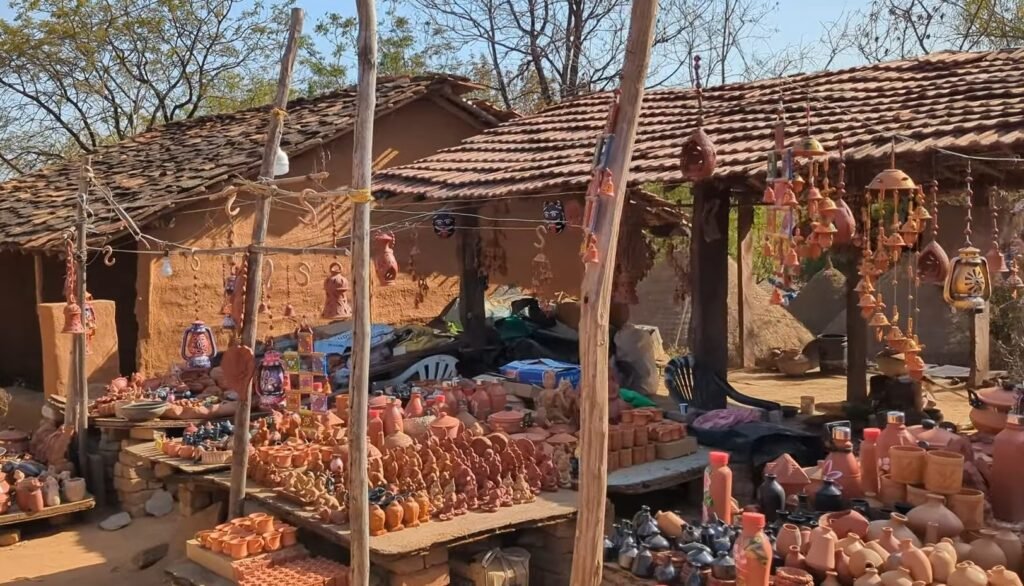
Handcrafts.
The local handicrafts are also worth buying. You can find wooden carvings, paintings, and handmade pottery that reflect the culture of the region. Prices can vary, starting from ₹200 for small items to several thousand for larger pieces.
7. Hajji Puran
A unique food item you can take home is Hajji Puran, a type of sweet made with dates and nuts. It’s a speciality of Aurangabad and makes for a great gift. You can buy a pack for around ₹200 to ₹500.
Where to Shop
The best places to shop in Aurangabad include local markets like Hindustan Market and Gulmandi, where you can find a variety of products. Shopping malls like Prozone Mall also offer a mix of local and branded goods.
Conclusion
This Aurangabad itinerary for 2 days is the perfect blend of history, culture, and nature. From Bibi Ka Maqbara and the spiritual Aurangabad Caves to the architectural marvel of Ellora and the majestic Daulatabad Fort, every experience in this city was immersive and educational. The journey into the past, coupled with the rich cultural experience left me feeling deeply connected to the history of India.
Whether you’re a history lower person an art lover, or a traveller Aurangabad has something to offer everyone. I left the city with the region’s history, art, and people. If you’re planning a trip, I highly recommend visiting this beautiful city—it’s truly a gateway to India’s rich heritage. Goodbye and take care…
Map Of Aurangabad/Chhatrapati Sambhajinagar.
Some FAQ about Aurangabad itinerary for 2 days.
1. What is Aurangabad famous for?
Aurangabad is famous for its UNESCO World Heritage Sites, the Ajanta and Ellora Caves. It is also home to the Bibi Ka Maqbara, often called the “Taj of the Deccan,” and has a rich Mughal history.
2. How many days are enough to explore Aurangabad?
I’d say two to three days are enough to cover the main attractions. In my 2-day visit, I comfortably explored Ajanta and Ellora Caves, Bibi Ka Maqbara, and Panchakki.
3. What is the best time to visit Aurangabad?
The best time is from October to March. I visited in November, and the weather was perfect—cool and pleasant for sightseeing.
4. How do I reach Aurangabad?
Aurangabad is well connected by air, rail, and road. I flew into Aurangabad Airport, but there are also trains and buses from major cities like Mumbai and Pune.
5. What are some must-visit places in Aurangabad?
The Ajanta and Ellora Caves, Bibi Ka Maqbara, and Daulatabad Fort are must-sees. Each site offers a glimpse into India’s architectural and cultural heritage.
6. Are there any local foods I should try?
Yes! Aurangabad is famous for its Naan Qalia, a flavorful Mughlai dish. I tried it at a local restaurant, and it was delicious.
7. Is Aurangabad safe for tourists?
Yes, Aurangabad felt very safe during my trip. The locals were friendly, and I had no issues while exploring the city alone.